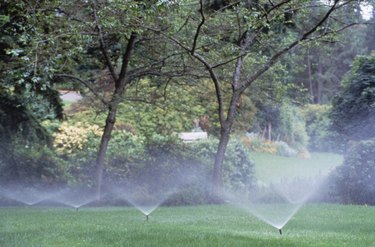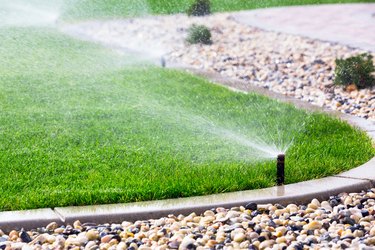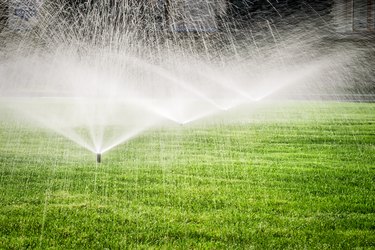
A Rain Bird automatic sprinkler system makes it easy to irrigate your lawn on schedule. There are many components to the system, and it is important that you have a basic understanding of Rain Bird sprinkler system troubleshooting to keep it up and running. Keep the owner's manual on hand, as there may be some differences among different models.
Rain Bird Controller Troubleshooting
Video of the Day
Begin Rain Bird sprinklers troubleshooting by checking the controller for an error message or light. For example, on the ESP-Me controller, a flashing LED error light may indicate that there was an issue with the setup, and you may need to set up the start time, watering duration or days to water. A solid LED may indicate a master valve or station short. This is usually caused by faulty wiring that you will need to repair to fix the issue.
Video of the Day
If the display on the controller is blank or frozen, there are a couple of possible causes. Make sure that the controller is plugged in, has a good battery and is getting power. You can also check the circuit breaker and reset it if needed. If there is power, try resetting the system. Another possible cause is that there was an electrical surge that affected the unit. Unplug the unit and then plug it back in after two minutes. If this doesn't work, it is possible that the controller was damaged by the surge and needs to be replaced.
Troubleshoot Watering Issues

If the controller seems to be working properly but the sprinklers aren't coming on, make sure that there is enough water. If there is a disruption to the water source, such as a problem with the main or if the shutoff valve is closed, there won't be water available to run the sprinklers. This is also true if water pressure is too low. Low pressure may be caused by other water running on the property, such as washing machines and showers, or it could be due to a broken pipe.
Some systems have a rain sensor feature so that you aren't irrigating if it is raining. This means that the sprinkler may not come on as scheduled if it has rained, and the system is actually functioning correctly. It could also mean that there is a problem with the sensor. Set the controller to "bypass."
If your sprinklers are delivering too much water, check the programming. Make sure each zone is not included in multiple programs. If necessary, adjust start times and shorten the run time to decrease water output.
Troubleshoot Rain Bird Valves

Watering problems may also be caused by an issue with the valves. After checking for issues with the controller and water supply, check that the valves are working. See if they work manually. If they do, select "manual start" from your controller and see if the solenoid clicks when activated. If it doesn't, it may be burned out and will need replacement.
Make sure the valves are installed in the correct direction and use "flush mode" to clean out any debris that may be clogging the valve. Check the valve for any leaks or cracks that may need to be fixed. Contact Rain Bird's technical service number if you need additional assistance or if you need to order parts.